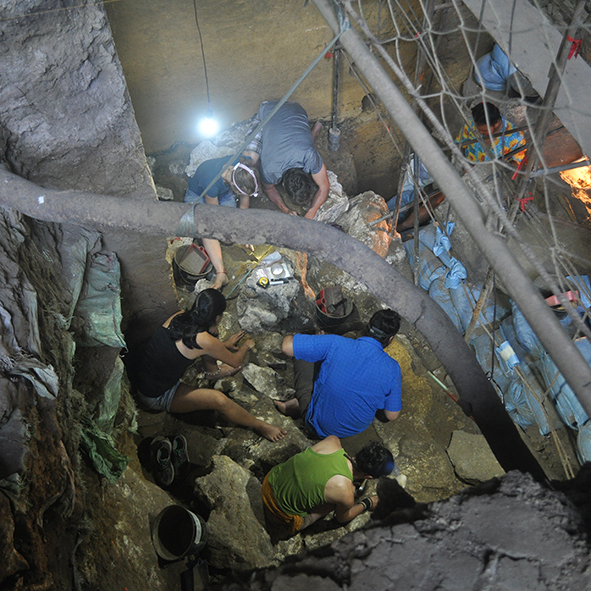卡劳洞穴和吕宋人的发现
Callao Cave and the discovery of the Homo luzonenesis
阿尔曼·萨尔瓦多·米亚雷斯 Armand Salvador Mijares
(菲律宾国立大学 University of the Philippines)
在菲律宾吕宋岛北部的卡老洞穴进行的考古调查发现了新的人种——吕宋人。这是欧亚大陆自2004年弗洛瑞斯人(H. floresiensis)公布以来的最重要的古人类学发现。对人类化石的直接测年以及借助于激光烧烛U系列在鹿齿上的间接测定表明,可追溯至5-6.7万年前。骨骼展示出的特点呈现出混杂性的特点,其具有古老的南方古猿相类似的特点和派生特点,以及与智人相类似的属性,这都表明了吕宋人独特的进化途径。弗洛瑞斯岛上的弗洛瑞斯人也表现出一些与吕宋人相似的明显的形态特征,其中包括体型矮小。两个岛屿上都存在中更新世人类定居的证据,这为我们研究在岛屿环境之下人类进化是趋同还是翻转提供了重要的时间尺度。
目前提出的吕宋人出现的最晚时间与中国和东南亚已知解剖学意义上的最早现代人类存在重叠。在菲律宾,迄今为止发现的最古老的遗存来自于4万年前的巴拉望岛塔邦洞穴, 但仍有可能发生相互影响。近来,在梁布亚考古地层学的重新评估表明,在晚期弗洛瑞斯人化石记录后不久,就有了智人的存在。基因研究也显示在菲律宾(和大洋洲)可能存在丹尼索瓦人,这增加了该地潜在的古人类多样性和潜在互动的可能性。
除吕宋人之外,在东南亚的岛屿和大陆也有一些重要的考古发现和研究,指出早在7万年前现代人类就迁移到了东南亚岛屿、苏拉威西岛上发现古人类的第一个证据以及印度尼西亚古人类多样性高于预期。
吕宋人的发现引起了菲律宾及国际媒体的广泛关注,《纽约时报》、《华盛顿邮报》等媒体均对其进行了大量的报道,关注度指数在2830左右。到目前为止,发掘出了13枚人类化石,包括5块掌骨和足骨,7颗牙齿(包括来自单个个体右上颌的5颗犬后齿)和未成年的股骨干,均出土于第14层。幼股骨干和两个右上颌第三臼齿表明至少有3个个体存在。骨骼特点呈现出古猿(原始)或南猿(类似于南方古猿)的混杂特征,以及更多派生特征或类似于智人的特征。但是仍存在一些重要的问题悬而未决。尽管有人提出,吕宋人太矮小了(一些新闻媒体报道称不到4英尺,约1.22米高),但到目前为止没有发现一具可以用来估测准确身高的骨骼遗骸。手和脚的形态特征表明,吕宋人具有爬树能力,但没有足够的细节来精确地重现移动能力和灵活性(尤其是手)。就进化过程而言,在吕宋人身上混杂的古老的特征和派生形态特征是吕宋岛上独立进化的结果吗?还是这种古人类的部分或全部体质特征,也就是与更古老的祖先如南方古猿共有的祖传特征?这些问题的答案不仅可以为吕宋人的进化史,更可以为岛屿上独立进化如何更广泛地影响原始人的进化轨迹提供宝贵的新见解。它还将使我们更好地了解古人类之间的祖先关系,甚至对古人类走出非洲、穿越欧亚大陆迁徙的时机做出解释。

在2010年,米哈雷斯等人报道了与古人类遗骸密切相关的哺乳动物骨骼碎片的发现。然而到目前为止,还没有在第14层找到任何人工制品。尽管如此,先前在卡老(Callao)的发掘工作已经能够解释第14层沉积物的沉积历史,从而说明沉积后对骨骼空间分布的影响。第14层是角砾层或碳酸钙胶结层。通过复原,发现是降水径流(雨水)导致骨骼碎片从靠近现存的南部入口的地方向洞穴内部移动。小块的“轻”骨头和松动的牙齿可能比较重的材料移动得更远,比如石制品,它们更靠近当前的洞穴入口。
在未来几年内,将在卡老洞穴及附近洞穴进行更多的考古发掘。研究小组希望找到更多具有诊断意义的化石遗存,以便回答身高、面部特征以及测年问题。
作者简介
阿尔芒·萨尔瓦多·贝拉诺·米亚雷斯是菲律宾大学考古研究项目的副教授。2012年至2016年曾任ASP董事,2007年至2011年任副董事。在加入研究院之前,米哈雷斯博士曾担任博物馆研究员和菲律宾国家博物馆陆地考古部门的负责人。
2006年,他获得了澳大利亚国立大学考古学和古人类学博士学位。他还拥有新墨西哥大学考古学人类学硕士学位和富布赖特学者学位,以及菲律宾大学人类学硕士学位。
他的研究兴趣包括更新世考古学、微痕分析、地质考古学和洞穴考古学。他在科学期刊上发表了许多文章,在学术出版社出版了许多书籍。作为一名人类学家,他对民多洛岛的曼吉安人进行了人种志研究。
米哈雷斯博士是“穿越时空:卡亚奥洞穴考古”项目的负责人。正是在这个项目中,他与一个国际团队合作,发现了新的原始人类物种:吕宋人。
Archaeological investigations at Callao Cave, northern Luzon, Philippines resulted in the discovery of new species of hominin, Homo luzonensis. This is the most significant palaeonthropological discovery in Eurasia since the announcement of H. floresiensis in 2004. Direct dating of human fossils and the indirect assays on deer teeth using laser ablation U-series indicate a minimum age of greater than 50 – 67 kya. The skeletal elements exhibit a mosaic of archaic (primitive) or Australopithecine-like features and more derived or H. sapiens like attributes that suggest a unique evolutionary pathway for Homo luzonensis. Homo floresiensis on the island of Flores also demonstrates some distinctive morphological traits not dissimilar to those of H. luzonensis, including small size. Both islands have evidence of Middle Pleistocene hominin colonization providing a significant time-depth to facilitate evolutionary convergence and/or reversal under the influence of insular evolution.
At present the youngest proposed dates for H. luzonensis overlap with the earliest known presence of anatomically modern humans in China and Southeast Asia. In the Philippines, the oldest remains identified so far are from Tabon Cave, Palawan date to after 40 kya, but there is still a possibility that interaction occurred. At Liang Bua, recent re-assessment of archaeological stratigraphy has indicated a presence of H. sapiens shortly after the latest H. floresiensis fossils recorded. Genetic studies also hint at a possible presence of Denisovans in the Philippines (and Australasia) adding to the potential hominin diversity and potential interaction in the region.
In addition to H. luzonensis there have been some other significant archaeological discoveries and research in Island and Mainland Southeast Asia that have suggested an early modern human migration into Island Southeast Asia by 70,000 years ago, the first evidence of a hominin presence on Sulawesi and greater than expected hominin diversity in Indonesia.
The discovery of H. luzonensis resulted in considerable media coverage both in the Philippines and internationally, being reported in outlets such as the New York Times and Washington Post, with an altmetric score amongst 2830. To date, the excavations have produced 13 hominin fossils, comprising five hand and foot bones, seven teeth (including five post-canine teeth from the right maxilla of a single individual) and the broken femur shaft of a juvenile. All the hominin skeletal elements were recovered from the same stratigraphic deposit, Layer 14. The juvenile femur shaft and two right maxillary 3rd molars indicates the presence of at least three individuals. The skeletal elements exhibit a mosaic of archaic (primitive) or Australopithecine-like features and more derived or H. sapiens like attributes. However, a number of significant outstanding questions remain. Although, it is proposed that H. luzonensis was diminutive (and reported in some news outlets to be less than 4 ft tall), none of the skeletal remains recovered so far are useful for estimating an accurate stature. Morphological characteristics in the hands and feet suggest that H. luzonensis possessed tree-climbing (arboreal) abilities but do not provide enough detail to precisely reconstruct locomotive capabilities and dexterity (especially in the hands). In terms of evolutionary process, are the mosaic of archaic and derived morphological characteristics observed in H. luzonensis a result of island evolution in isolation on Luzon, or are some or all of the physical traits exhibited by this hominin symplesiomorphic – that is ancestral characteristics shared with much more ancient ancestors such as Australopithecus? Answers to these questions would provide invaluable new insights not only into the evolutionary history of H. luzonensis but how isolation on islands influences the evolutionary trajectories of hominins more generally. It will also provide us with a greater understanding of the ancestral relationships between hominin species and even our interpretations of the timing of hominin migrations out of Africa and across Eurasia.
In 2010 Mijares and others reported the recovery of several fragments of mammal bone with cutmarks in close association with the hominin remains. However, as yet no artefacts have been recovered from Layer 14. However, previous excavations at Callao have enabled interpretation of the depositional history of the Layer 14 sediments that illustrate the post-depositional impacts on the spatial distribution of bones. Layer 14 is a bone breccia or cemented calcium carbonates layer. The reconstructions suggest that precipitation run-off (rainwater) has resulted in the movement of bone fragments from close to where the southern entrance now exists towards the cave interior. Small pieces of ‘light’ bone and loose teeth have potentially moved further than heavier materials such as stone artefacts, which remained closer to the current cave entrance.
More archaeological excavation at Callao Cave and nearby caves are planned in the next few years. The team is hoping to recover more diagnostic fossil remains that may answer question of stature and facial attributes as well as address some of the dating problems.
Biographic Sketch

Armand Salvador B. Mijares is an Associate Professor 7 and a UP Scientist 1 at the Archaeological Studies Program, University of the Philippines. He was a former Director ASP from 2012 to 2016 and Deputy Director from 2007-2011. Prior to joining the academe, Dr Mijares worked as a Museum Researcher and Head of the Terrestrial Archaeology Section of the National Museum of the Philippines.
He received his PhD in Archaeology and Palaeoanthropology from the Australian National University 2006. He also has an MS in Anthropology major in Archaeology from the University of New Mexico as a Fulbright scholar and an MA in Anthropology from the University of the Philippines.
His research interest is on Pleistocene Archaeology, lithic usewear analysis, geoarchaeology and cave archaeology. He has published numerous articles in scientific journals and book chapters in academic press. As an anthropologist he has conducted ethnographic research among the Mangyans of Mindoro Island.
Dr Mijares is the Project Head of the Going Deep in Time: The Archaeology of Callao Cave. It is in this project, in collaboration with an international team, that he discovered the new hominid specie: the Homo luzonensis.
